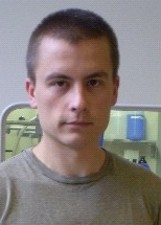Org. Synth. 2008, 85, 278
DOI: 10.15227/orgsyn.085.0278
TERT-BUTYL TERT-BUTYLDIMETHYLSILYLGLYOXYLATE: A USEFUL CONJUNCTIVE REAGENT
Submitted by David A. Nicewicz, Guillaume Brétéché, and Jeffrey S. Johnson
1.
Checked by Christopher Bryan and Mark Lautens.
1. Procedure
A.
tert-Butyl diazoacetate (Note 1). A modification of Dailey's procedure was employed.
2 A 1-L, two-necked, round-bottomed flask equipped with a Teflon-coated magnetic stir bar (4.1 × 1.9 cm) and a thermometer (one neck is left open) is charged with
4-acetamidobenzenesulfonyl azide (25.55 g, 106 mmol, 1.0 equiv) (Note 2),
tert-butyl acetoacetate (17.6 mL, 17.1 g, 106 mmol),
tetrabutylammonium bromide (0.68 g, 2.12 mmol, 0.02 equiv) and
pentane (300 mL) (Note 3). The suspension is stirred and cooled to 0 °C in an ice-bath. An aqueous solution
(100 mL) of sodium hydroxide (12.0 g, 300 mmol, 2.8 equiv) is added in several portions over 15 min, to create a suspension of a white solid in a yellow supernatant. The empty neck is fitted with a gas inlet adaptor with stopcock and is vented to the atmosphere. The suspension is stirred for 20 h at ambient temperature. The white solid is removed by filtration through Celite
(Note 4) and the pad is washed with 50 mL of pentane. The filtrate is transferred to a 1-L separatory funnel, and the aqueous phase is separated
(Note 5) and extracted with three 70-mL portions of pentane. The combined organic extracts are washed with two 150 mL-portions of deionized water and
150 mL of brine, then are dried over MgSO
4 (ca. 7 g) for 10 min, filtered through a funnel packed with glass wool, and concentrated by rotary evaporation
(Note 6) to yield
13.18 – 13.24 g (88 %) of tert-butyl diazoacetate as a yellow liquid that was used directly in the next step
(Note 7).
B.
tert-Butyl tert-butyldimethylsilyldiazoacetate. A modification of Bolm's method was employed.
3 A flame-dried, 500-mL, two-necked, round-bottomed flask equipped with a Teflon-coated magnetic stir bar (2.5 cm × 1.3 cm), a thermometer and a rubber septum is maintained under an inert atmosphere of argon and charged with
N,N-diisopropylethylamine (19.3 mL, 14.7 g, 111 mmol, 1.2 equiv),
tert-butyl diazoacetate (13.18 g, 92.8 mmol) and
anhydrous diethyl ether (125 mL) (Note 8). The solution is stirred and cooled to −30 °C in a cryocooler.
tert-Butyldimethylsilyl trifluoromethanesulfonate (25.6 mL, 29.4 g, 111 mmol, 1.2 equiv) is added dropwise via syringe over 15 min
(Note 9). The yellow mixture is stirred for 24 h at −25 °C in a cryocooler
(Note 10). The progress of the reaction is monitored by thin layer chromatography
(Note 11). The mixture is filtered through Celite
(Note 4) and the pad is washed with 50 mL of diethyl ether. The filtrate is concentrated by rotary evaporation (≤ °C bath temperature, ≥70 mmHg) to yield
25.68 – 26.65 g of crude tert-butyl tert-butyldimethylsilyldiazoacetate as a yellow oil
(Note 12).
C. tert-Butyl tert-butyldimethylsilylglyoxylate. A 1-L, three-necked, round-bottomed flask fitted with an overhead mechanical stirrer (fitted with a 6.0 × 2.0 cm Teflon paddle), a thermometer is charged with sodium bicarbonate (62.3 g, 742 mmol, 8.0 equiv), deionized water (210 mL) and acetone (150 mL) through the open neck. The mixture is mechanically stirred (600 rpm) and cooled to 0 °C in an ice-bath. Oxone® (114 g, 185 mmol, 1.85 equiv) is added in several portions (Note 13). A solution of crude tert-butyl tert-butyldimethylsilyldiazoacetate from Step B (25.68 – 26.65 g, 100 – 104 mmol) in dichloromethane (180 mL) is added to the reaction mixture all at once (Note 14). The resulting yellow mixture is stirred and cooled in the ice-bath for approximately 2 h. The progress of the reaction is monitored by TLC until no starting material is present (Note 15). The insoluble salts are removed by filtration through Celite (Note 4) and the pad is washed with two 25-mL portions of dichloromethane. Deionized water (150 mL) is added to the filtrate and the biphasic mixture is transferred to a 1-L separatory funnel. The organic layer is separated and the aqueous phase is extracted with two 50-mL portions of dichloromethane. The combined organic extracts are dried with Na2SO4 (ca. 50 g) for 10 min, then are filtered through a funnel packed with glass wool, and concentrated by rotary evaporation (≤ °C bath temperature, ≥70 torr) to give 21.1 – 23.4 g of a yellow oil (Note 16). The product is purified by flash column chromatography (Note 17), to yield 12.27 – 12.62 g (50.2 – 51.1 mmol, 47 – 49 % for three steps) of pure tert-butyl tert-butyldimethylsilylglyoxylate as a yellow oil (Note 18).
2. Notes
1.
This compound is commercially available from Aldrich Chemical Company.
2.
4-Acetamidobenzenesulfonyl azide (97%) was purchased from Alfa Aesar and used as received. The submitter's material was synthesized using the procedure of Davies.
43.
tert-Butyl acetoacetate (98%) (d = 0.954 g/mL) was purchased from Aldrich Chemical Company.
Tetrabutylammonium bromide (99+%) was purchased from Acros Organics.
Sodium hydroxide and pentane were purchased from Fisher Scientific. All reagents were used as received.
4.
All filtrations with Celite were performed using a slurry of Celite in the reaction solvent in a 10.5-cm diameter fritted funnel. The height of the Celite pad was 1.0 – 1.5 cm.
5.
The organic phase is yellow whereas the aqueous is red.
6.
The temperature of the bath should be kept below 20 °C to prevent distillation of the
tert-butyl diazoacetate. The pressure should be ≥70 mmHg.
7.
1H NMR data for
tert-butyl diazoacetate:
pdf (400 MHz, CDCl
3) δ: 1.46 (s, 9 H), 4.61 (s, 1 H).
8.
N,N-Diisopropylethylamine (98%) (d = 0.742 g/mL) was purchased from Fluka and distilled from calcium hydride before use (80 °C, 50 mm Hg). Diethyl ether was purified using an MBRAUN solvent purification system by percolation through a column of activated alumina.
9.
tert-Butyldimethylsilyl trifluoromethanesulfonate (d = 1.151 g/mL) was purchased from Oakwood Products, Inc. and was used as received. During the addition of
tert-butyldimethylsilyl trifluoromethanesulfonate the temperature increases from −30 °C to −25 °C. A white precipitate forms as well.
10.
A Neslab CB-80 cryocooler was employed to maintain reaction temperature.
11.
The yellow mixture is analyzed by thin layer chromatography (TLC; silica gel plates cut from 20 × 20 aluminum sheets (Silica gel 60 F
254 from EMD Chemicals)), eluting with petroleum ether/EtOAc, 9:1 (R
f = 0.95 for
tert-butyl
tert-butyldimethylsilyldiazoacetate, R
f = 0.67 for
tert-butyl diazoacetate). Visualization was accomplished with UV light and by staining with aqueous ceric ammonium molybdate solution followed by heating.
12.
The submitters reported a yield of 22.48 g of 80 – 85 % purity. The checkers were unable to determine the purity of the crude material; 100% conversion was assumed. The silanol derived from hydrolysis of the silyl triflate is the main impurity (the submitters report that this accounts for around 9% of weight). Some of the ammonium salt produced during the reaction may be present as well. Purifying the compound at this stage is not trivial on this scale and there is no advantage to doing so since the impurities are easily rejected in the last step. A sample was purified by flash chromatography using petroleum ether/Et
2O, 99:1 in order to obtain spectroscopic data. Analytical data for
tert-butyl
tert-butyldimethylsilyldiazoacetate: IR (thin film), cm
−1: 2951, 2928, 2858, 2087, 1685, 1470, 1391, 1367, 1280, 1248, 1159, 1084, 838, 827, 803, 778, 675;
1H NMR
pdf (400 MHz, CDCl
3) δ: 0.21 (s, 6 H), 0.96 (s, 9 H), 1.48 (s, 9 H).
13C NMR
pdf (100 MHz, CDCl
3) δ: −6.2, 18.8, 26.4, 28.3, 81.0, 169.1. Anal. Calcd. for C
12H
24N
2O
2Si: C, 56.21; H, 9.43; N, 10.92. Found: C, 56.08; H, 9.59; N, 10.68.
13.
Sodium bicarbonate (certified ACS) and acetone (99+%) were purchased from Fisher Scientific.
Oxone® monopersulfate was purchased from Alfa Aesar, and it was used as received. As the Oxone
® monopersulfate is added to the reaction mixture, gas is evolved.
14.
Dichloromethane (99.5%) was purchased from Fisher Scientific and used as received. As the
tert-butyl
tert-butyldimethylsilyldiazoacetate is added, the mixture turns bright yellow.
15.
Since it is a two phase reaction, the reaction time depends on the strength of the mechanical agitation. The yellow mixture is analyzed by thin layer chromatography (TLC), eluting with petroleum ether/Et
2O, 9:1 (R
f = 0.83 for
tert-butyl
tert-butyldimethylsilylglyoxylate, R
f = 0.95 for
tert-butyl
tert-butyldimethylsilyldiazoacetate). Visualization is accomplished with UV light and on staining with aqueous ceric ammonium molybdate solution followed by heating.
16.
The submitters reported a yield of 19.8 g. The compound is somewhat volatile and considerable amounts can be lost by extended exposure to high vacuum.
17.
Flash column chromatography was performed on a silica gel column (23 cm length × 9 cm width, 720 g of silica gel) (Silicycle, grade 40 – 63μ). The compound was dissolved in 25 mL of petroleum ether. The silanol by-product was eluted with 1 L of petroleum ether and then the product was eluted with petroleum ether/Et
2O, 24:1 (ca. 2.7 L of eluent are required before collecting fractions) Collected fractions (eight 200-mL yellow fractions) were analyzed by thin layer chromatography (TLC), eluting with petroleum ether/Et
2O, 24:1 (R
f = 0.49 for
tert-butyl
tert-butyldimethylsilylglyoxylate). Visualization was accomplished with UV light and on staining with aqueous ceric ammonium molybdate solution followed by heating.
18.
tert-Butyl
tert-butyldimethylsilylglyoxylate displayed the following physicochemical properties: IR (thin film) cm
−1 2931, 2860, 1716, 1657, 1464, 1369, 1252, 1159, 993, 841, 785;
1H NMR
pdf (300 MHz, CDCl
3) δ: 0.27 (s, 6 H), 0.96 (s, 9 H), 1.55 (s, 9 H);
13C NMR
pdf (75 MHz, CDCl
3) δ: −6.6, 17.1, 26.6, 28.1, 83.6, 163.0, 232.9. Anal. Calcd. for C
12H
24O
3Si: C, 58.97; H, 9.90. Found: C, 58.81; H: 9.98.
Handling and Disposal of Hazardous Chemicals
The procedures in this article are intended for use only by persons with prior training in experimental organic chemistry. All hazardous materials should be handled using the standard procedures for work with chemicals described in references such as "Prudent Practices in the Laboratory" (The National Academies Press, Washington, D.C., 2011 www.nap.edu). All chemical waste should be disposed of in accordance with local regulations. For general guidelines for the management of chemical waste, see Chapter 8 of Prudent Practices.
These procedures must be conducted at one's own risk. Organic Syntheses, Inc., its Editors, and its Board of Directors do not warrant or guarantee the safety of individuals using these procedures and hereby disclaim any liability for any injuries or damages claimed to have resulted from or related in any way to the procedures herein.
3. Discussion
Silylglyoxylates were first synthesized by Ando's laboratory via dye-sensitized photooxidation of α-silyl α-diazo esters. Yields were ca. 40%.
5 Ozonolysis of ethyl trimethylsilyl diazoacetate has also been reported to afford the corresponding silyl glyoxylate in 30% yield with 15% over-oxidation to the silyl ester.
6 Recently silylglyoxylates were used by Bolm in the preparation of α-silyl α-hydroxy acetic acids.
3 The synthetic route involved
C-silylation of benzyl diazoacetate and subsequent Rh(II)-catalyzed oxo transfer using propylene oxide. We have modeled the route presented herein on the Ando/Bolm route, incorporating an alternative oxo transfer that is more broadly applicable to sterically hindered substrates and does not require the use of Rh
2(OAc)
4. The diazo to oxo conversion is based on a recent report by Wang that uses Oxone® to transform α-diazo esters to α-keto esters.
7 The use of this oxidation does indeed work for the synthesis of silyl glyoxylates and moreover, allows for the synthesis of some highly hindered substrates (Table 1).
8 Since
tert-butyl diazoacetate is fairly expensive, it is more cost effective to begin from
tert-butyl acetoacetate. The diazo transfer and retro-Claisen condensation (deacylation) is conveniently achieved in one step using Davies's reagent
4 and applying a procedure adapted from Dailey.
2 Intermediates are not purified in the sequence. Impurities are efficiently rejected in the final purification by silica gel chromatography, the progress of which can be easily monitored due to the bright yellow color of the product.
Table 1.
In addition to the hydrogenation work of Bolm, α-silyl-α-keto esters (silyl glyoxylates) react with alkynyl, vinyl, and hydridic nucleophiles to afford alkoxides that rearrange to glycolate enolates.
9,10 The [1,2]-Brook rearrangements
11 common to these reactions are presumably facilitated by the ester group. The nascent nucleophiles can be trapped with aldehydes to give aldol products wherein the two hydroxyl groups are differentiated. Silyl glyoxylates may prove useful in other reactions involving complementary nucleophilic and electrophilic reactants and the route described herein provides flexibility in both the ester group and silyl group of the reagent.
Figure 1.
Appendix
Chemical Abstracts Nomenclature (Collective Index Number);
(Registry Number)
Sodium azide; (26628-22-8)
N-Acetylsulfanilyl chloride; (121-60-8)
4-Acetamidobenzenesulfonyl azide; (2158-14-7)
tert-Butyl acetoacetate; (1694-31-1)
Tetrabutylammonium bromide; (1643-19-2)
tert-Butyl diazoacetate; (35059-50-8)
tert-Butyldimethylsilyl trifluoromethanesulfonate; (69739-34-0)
N,N-Diisopropylethylamine; (7087-68-5)
Oxone® monopersulfate; (37222-66-5)
 |
Jeffrey Johnson received his B.S. in Chemistry from the University of Kansas in 1994 (Highest Distinction and Honors in Chemistry). He obtained his Ph.D. from Harvard University in the laboratory of Professor David Evans in 1999 and was an NIH Postdoctoral Fellow with Professor Robert Bergman at the University of California at Berkeley from 1999–2001. He has been at the University of North Carolina since 2001.
|
 |
David Nicewicz received his B.S. (2000) and M.S. (2002) in Chemistry from the University of North Carolina at Charlotte. He joined the laboratory of Professor Jeffrey Johnson at the University of North Carolina at Chapel Hill in 2001 where he studied enantioselective catalysis and natural product synthesis and was funded in part by an ACS Division of Organic Chemistry fellowship (Novartis Pharmaceuticals, 2004–2005). David completed his Ph.D. studies in 2006 and is currently a NIH Ruth L. Kirschstein NRSA postdoctoral fellow in the laboratory of Professor David MacMillan at Princeton University.
|
 |
Guillaume Brétéché was born in 1984 in Nantes, France. He graduated from the Chemistry School of Toulouse with a M.S degree in 2007. His last year of undergraduate studies was completed at the University of North Carolina, Chapel Hill where he joined Professor Jeffrey Johnson's group. His research focused on the synthesis of silyl glyoxylates. He is currently employed by Arkema and works on synthesis of organic monomers for application in fuel cell membranes.
|
 |
Christopher Bryan was born in Winnipeg, Canada in 1982. He received his B.Sc. degree with distinction in 2005 from the University of Victoria, where he worked in the laboratory of Scott McIndoe. While an undergraduate, he worked as a Co-op student in the medicinal chemistry department at Boehringer-Ingelheim Pharmaceuticals in Laval, PQ. He is currently pursuing his Ph.D. at the University of Toronto under the supervision of Professor Mark Lautens. His research is focused on the synthesis of heterocycles via metal-catalyzed tandem processes.
|
Copyright © 1921-, Organic Syntheses, Inc. All Rights Reserved